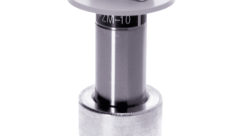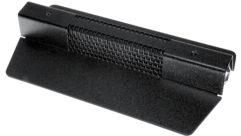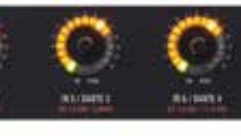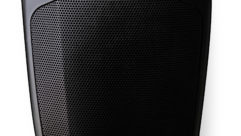
The boundary microphone put a few simple principles of soundwave physics into practical use and revolutionized minimal miking for boardrooms and videoconferencing. Built into conference tables, they nearly vanish or appear to be only a piece of the furniture. The automatic microphone mixer, brainchild of Dan Dugan, has had a very different story, applying increasingly complex algorithms to produce a natural sounding mix of microphones especially in free ranging and unpredictable talk formats. Its primary contribution has been in allowing its user, pro or beginner, to connect the mics, set some initial levels, and walk away. These devices, working in their own uniquely unobtrusive way, have democratized sound setup and now form the technical foundation of many sophisticated conferencing and meeting facilities. Our survey captures the latest features and functions of these wonderfully useful machines.

AKG_DMM14 U

AKG_PCC170
The PCC170 professional boundary layer microphone from AKG has a super cardioid pattern to minimize background noise pickup and its bass tilt switch can be used to adjust bottom end response, and minimize room and HVAC rumble. The unit’s RFI suppression rejects interference from cellphones and other RF devices. The PCC170 SW includes a programmable membrane button that can set the mic into on, off, momentary-on, and momentary-off modes. Also from AKG, the DMM14 U digital automatic microphone mixer can be cascaded up to 10 units and a total of 140 channels. Offering 14 inputs including analog, USB, and DANTE streams, the DMM14U can route any input to any of its outputs as well as a direct out of each input to serve for multi-track recording. There is 12-band graphic EQ on each output and the mixer has six programmable presets.


Audio-Technica_ATW T1006
Audio-Technica_AT-MX341b
Operating with a System 10 or System 10 Pro receiver, the Audio-Technica ATW-T1006 wireless cardioid condenser boundary mic uses the 2.4Ghz band to transmit and its touch-sensitive switch can select between talk and mute modes or to press-to-talk or press-to-mute. The mic also has two red/green LED indicators on the outside of the case to show toggle/talk/mute mode, battery level, and charging status. There are three input level settings including -6dB, 0dB, and +6dB along with a switchable low cut filter. The 3.7V rechargeable battery provides enough power on a full charge to run the transmitter for up to nine hours. The AT-MX341b automatic mixer uses proprietary algorithms for seamless operation while it functions in either one-channel-at-a-time operation, all channels active, or any mix of moderator override. The last mic on stays on and any number of SmartMixers can be linked to create a larger system.

Audix_M60
Designed by Audix to reject RF from outside sources such as wireless intercoms and cellphones, the M60 miniaturized condenser microphone exhibits a “hemi-cardioid” polar pattern when used as a boundary mic. There is a shock absorbent material on the bottom side to minimize rumble and vibration. This shares the bottom plane with two holes that can be used to mount the unit on a wall. The 25ft. shielded mic cable can exit the case at either 180 or 90 degrees to suit the mounting scheme and it may be terminated in a male XLR or Phoenix connector. The mic operates on 18-52V phantom power and it is available in satin nickel, black, or white finish. Developed primarily for speech pickup, the microphone has a frequency response from 70Hz to 8kHz and a signal to noise ratio of 72dB.

beyerdynamic_QuintaTB
The new Quinta TB wireless boundary microphone from beyerdynamic is designed for meeting rooms, huddle rooms, or video conferencing. The triple-band technology of the Quinta family ensures transmission with highest HD audio quality while the 128-bit encryption and 24-bit PIN code make the system’s emissions secure. The multi-channel receiver features an operating time of 14 hours and a quick recharge time. Different operating modes can be selected via the Quinta software. In the microphone mode, the Quinta control unit acts as a multi-channel receiver with which up to four Quinta TB microphones can be operated simultaneously. In this mode, several control units can be connected via the Quinta software. In the conference mode, the Quinta TB microphone acts as a delegate unit and can be used for any conventional conferencing application.

CAD Audio Astatic_901VP
In addition to its RF interference rejection, the 901VP condenser boundary microphone from CAD Audio has a continuously variable polar pattern to perfectly adjust it for the room. The polar pattern can be changed remotely by setting the onboard variable pattern control to a figure-eight and adding CAD Audio’s Remote Variable Pattern Control Box (VPC-1) between the mic and mixer. It is also equipped with an 80Hz, 12dB/octave high-pass filter. There is a TA3M-type connector recessed into the body and the 901 VP comes with 30ft. of mic cable terminated in a standard 3-pin male XLR connector. When used with compatible digital platforms, the polar pattern can also be electronically controlled using the 40-360 DSP cable and corresponding software.

Clearone Tabletop Microphone

Clearone SR 1212
The Tabletop Microphone from Clearone uses a unidirectional pickup pattern for conferencing to maximize on-axis range. This also helps keep out background noise which is further reduced with the low-cut filter. The unfiltered frequency response is 50Hz to 18kHz and the mic is phantom powered on 9V to 52V through the XLR terminated cable. The Tabletop Microphone is also available in a wireless version for the WS800 and new DIALOG 20 wireless microphone systems. For automated mixing in conference applications, Clearone has the Converge SR 1212 with Ethernet, RS-232, and USB connectivity, remote management through HTML and SNMP, event scheduler, and eight mic gating groups.

Clockaudio MR88

Clockaudio C012E-RF
Clockaudio has a wide range of boundary mics and among the in-table models is the C 012E-RF in black finish and the C 012ENRF in nickel finish. U sing a 0 .94in. mounting hole, the mic fits cleanly into a conference table to provide a very low profile protrusion above the surface. It exhibits a cardioid pickup pattern with a frequency response of 50Hz to 18kHz and sends the output to a male XLR connector. The power adaptor runs the mic on 9-48V phantom power and includes filters that will eliminate all GSM frequencies from 800-1200 MHz. Clockaudio also offers the MR 88 8-channel automatic mixer with direct outs on each channel, 2-channel outputs on RCA and XLR, multi-level channel priority system and individually selectable 48V phantom power. There is also switched compression, 12dB HF/LF boost/cut along with remote VCA control and RS232.

Dugan Sound Design_E-3
Outwardly identical to the Models E-1A and E-2 automixers, the Dan Dugan Sound Design E-3 is for handling AES digital signals. The mixer can operate in a number of modes including AES 8-channel, Dugan Speech System, and Dugan Gain Limiting with a pre/post mix matrix for six aux outputs. Up to eight units can be linked into one system in an optical ring network and the system can be controlled on the front panel or through the Model CP-2 control panel. Other control options include the Dugan Control Panel for Java or the Dugan Control Panel for iPad. As with the front panel on the other models, the E-3 has individual level metering, a bypass button and a mute button on each channel.

Earthworks CTB30
The Earthworks CTB30 boundary microphone, with a 4.1in. diameter, provides a pristine sounding microphone solution for conferencing when a low profile is of the utmost importance. It features an omni semisphere polar pattern and a frequency response of 60Hz to 30kHz with a 60Hz notch filter that greatly reduces any finger tapping or thumping on the surface. This semisphere polar response allows the use of fewer microphones, while obtaining higher intelligibility than with conventional boundary microphones and rejecting RFI. Available in silver or Nextel black finish, the CTB30 features a 10ft. cable terminated in a standard 3-pin XLR, providing the option to set up a temporary conferencing space or mount the microphone through the table.

Lectrosonics SPN1612
With its 48 mix busses and Proportional Gain Algorithm, the SPN1612 from Lectrosonics can scale up to whatever size is needed and the IP control capability puts it right on the network where its single CAT6 connection carries 1Gbs audio, control and data signals. Its 16 mic/line inputs provide 48V phantom power and outputs 1-8 are line level while 9-12 are mic/line. The monitor output can bring up any of the 48 final mixes and any physical output can deliver the signal from any output in the matrix. The two rack space unit can be controlled through Ethernet, USB, RS-232, and logic I/O ports using the large command library. On the SPN1612 each output has a signal processing chain, gain control and limiter ahead of the digital to analog converter.

MXL AC-424
For web communication MXL has the AC-424 web conferencing USB microphone running on USB bus power and picking up speech to a distance of about 25ft. It uses a three-capsule array to produce a polar pattern of 180 degrees and a frequency response from 40Hz to 16kHz. Compatible with PC or MAC through USB 1.1 and 2.0, its all metal body has a backlit mute button and a headphone jack for private conferencing. The black, rounded case with its low profile blends into the conference room furniture. Accessories include a USB cable and microfiber cleaning cloth.

Rane AM1
Rane has a compact 1RU solution to handling multiple microphones in the AM1 with its gain-sharing automatic mic mixing. Each of its four XLR inputs can take mic, mic with 48V phantom, or line level signals, and along with the rotary manual level control there is a signal presence/overload indicator light. The two aux inputs on RCA and 3.5mm are independently mono switchable at the output. In addition to these, the AM1 also provides a 16-bit, 48 kHz USB audio input. For recording the unit has dual RCA outputs, headphone out on 1/4in. and 3.5mm with level control as well as a USB output and charging port. The Cascade In port connects up to seven Rane AM2 automixers for a total of 60 gain-shared mics while the RAD Port sends output to Rane HAL or Mongoose systems.

Revolabs Executive Elite
Among the Executive Elite wireless microphones from Revolabs are the tabletop directional and omnidirectional models. Running for up to 20 hours on a single charge using standard AA nickel metal hydride (NiMH) rechargeable batteries. The mics have a mute button along with an “always on” option, and the LEDs on the mic body indicate the mute status. Both models have a frequency response of 100Hz to 20kHz. For longer conferences, the Revolabs Executive Elite Cross-Over adapter allows either of these microphones to be charged while in use. Also available in the Executive Elite line are the 6in. and 12in. gooseneck and the wearable Presenter microphone.

Sennheiser MEB 114-S
The Sennheiser MEB 114-S is designed primarily as a conferencing microphone. Powered on 24V to 48V, the mic has a frequency response of 40Hz to 20kHz and a 120dB maximum sound pressure level. The -S version also features a programmable button that can be set up for push-to-talk, push-to-mute, toggle on/off and permanent on with external LED control by way of the external logic input. The bi-color LED ring is used for status indication. The MEB 114-S can also trigger a media control system or camera through its TTL logic output on the bottom of the unit. It produces a cardioid pickup pattern with an effective dynamic range of 111dB. The case is available in a choice of black, white, and Nextel gray finish.

Shure SCM810 and MX396
Shure has developed the MX396 Microflex Multi-Element Boundary microphone available in either a two- or three-element configuration. Each element has a separate audio output for individual control as if multiple microphones were being used. The coverage can be set to a number of different polar patterns including bidirectional. Powered on 48V to 52V phantom, the MX396 also has a programmable button for momentary contact on, push-on/push-off and always on for use with an automatic mic mixer. These settings are made on DIP switches in the bottom of the case. Status is indicated on a bi-color LED. Also from Shure is the SCM810 8-channel automatic mixer with balanced mic-line inputs and one aux level input along with eight unbalanced direct line level outputs. Other features include an adjustable peak output limiter, selectable 46V phantom power on each channel and linking capability for up to 400 sources.

Sound Devices 688
One of the most versatile road mixers ever designed, the Sound Devices 688 field production mixer can output stereo while doing multitrack feeds from six line/mic XLR inputs and six more line inputs. It also incorporates the Dugan Speech System substantially widening the ways the 688 can be used. Also onboard is the Sound Devices MixAssist system which automatically attenuates the channels that are not active. The 688 offers 16-track, polyphonic, or monophonic broadcast WAV file recording to SD and CompactFlash cards. The unit also features a 10-second power reserve that will allow it to stop recording and safely power down in the event of an external power loss.

TOA Electronics EM600
The TOA Electronics EM-600 flush-mount boundary microphone delivers an omni-directional pickup pattern for covering wide areas from walls, ceilings, and desktops. A tiny fraction over 1in. in diameter, the structure nearly disappears into the mounting surface. The 30Hz to 20kHz frequency response can be altered with the low-cut filter to reduce noise and room rumble below 100Hz. The mic operates on 9V to 52V phantom power and its two supplied rubber isolation rings can be used to further reduce mechanical thumps and vibration. The unit is equipped with a male XLR connector for a balanced 200Ω audio output.

Yamaha QL1 and MRX7-D
Built-in Dante 64 in/out digital networking lays a strong foundation for the Yamaha Commercial Audio MRX7-D signal processor and it adds automatic microphone control with the Dugan automixer, acoustic echo cancellation, and a speech privacy function that can mask conversations by using an information masking tone synthesized from elements of human speech. The front panel SD memory card slot allows direct playback of MP3/WAV format audio files. The MRX7-D also has RS-232 and Ethernet control capability to work with a variety of external systems. The MTXMRX editor software provides independent component configuration with a device layout wizard and a setup section for the external controllers.
More Online
AKG
www.akg.com
Audio-Technica
www.audio-technica.com
Audix
www.audixusa.com
beyerdynamic
www.beyerdynamic.com
CAD Audio
www.cadaudio.com
Clearone
www.clearone.com
Clockaudio
www.clockaudio.com
Dan Dugan Sound Design
www.dandugan.com
Earthworks
www.earthworksaudio.com
Lectrosonics
www.lectrosonics.com
Rane
www.rane.com
Revolabs
www.revolabs.com
Sennheiser
www.sennheiserusa.com
Shure
www.shure.com
Sound Devices
www.sounddevices.com
Yamaha Commercial Audio
www.yamahaproaudio.com










